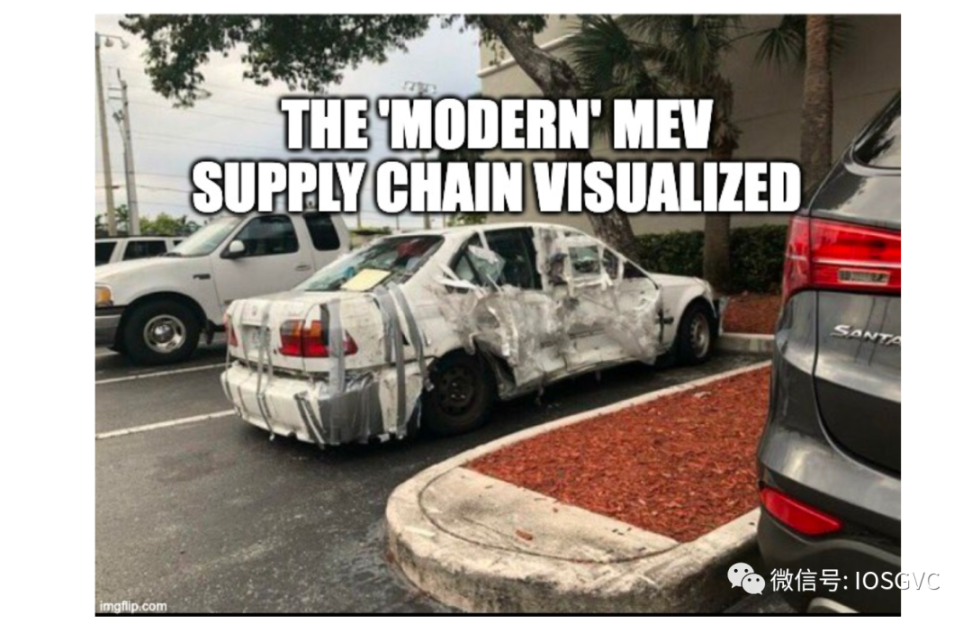IOSG Ventures: Observing order flow innovation from the Ethereum transaction life cycle
Original author: Jiawei, IOSG Ventures
Preface

Source: Flashbots
I often use this picture when sharing Infras investment logic with others - it is interesting to look at different Infra projects through the perspective of the MEV supply chain (or transaction life cycle).
Thanks to the tireless efforts of many researchers, we have transitioned from the MEV dystopia of a few years ago to a relatively clear supply chain, although there are still many challenges that need to be solved.
In the context of this supply chain, order flow plays a key role. If we compare the supply chain to a river bed, then the order flow is the river flowing on top of it. In this article, we will address some of the key points of order flow.
Orderflow…wat do?

Source: IOSG Ventures
Quintus defines an “order” as anything in Ethereum that can change the state of the blockchain. To put it more simply, we can also understand a transaction as an order. In the diagram above we try to depict the journey of an order flow through the supply chain. However, the real situation may be like this...

Source: Frontier
Of course, this article wont attempt to break down all the details. The MEV supply chain has become so large and complex that it is almost impossible to spell out all the details in a short period of time. Therefore, in this article we focus on two things: private order flow and order flow auctions (OFA).
Private Orderflow Dominance
Public mempools will dry up… - Hasu
When talking about private order flow, we usually see two terms - Private Order Flow (Private Order Flow) and Exclusive Order Flow (Exclusive Order Flow). There is a semantic difference between these two terms. For example, MEVBlocker bypasses Public Mempool and sends order flow directly to Top Builders. At this time the order flow is private, but not exclusive to any Builder. Furthermore, OFA is often not a private transaction, as one can subscribe to OFAs order flow (although this may have access control) and observe the transactions within it. This is usually done to maximize competition among the different actors in the auction.
There has been a lot of discussion in the community about private order flow and how it can be a driver of centralization.

Source: IOSG Ventures
In the entire MEV supply chain, Builder is a very competitive market. Order flow, as the most basic means of production in block construction, has naturally become a battleground for military strategists. In this case, Builders often provide a variety of services to attract order flow from upstream:
Transaction pre-confirmation: For example, Vitalik mentioned in his SBC 2022 speech: The Builder can publicly declare that if the user sends a transaction with a Priority Fee greater than 5, the Builder will immediately send an enforceable message promising to include this Transaction; if the Priority Fee is greater than 8, the user can even get a Post-state Root. This is useful in some use cases where there is competition for block space.
Front-running protection, which is also the main selling point of most OFAs.
Revert protection. If a Bundle fails or Reverts, the Builder will not include it (meaning the user does not need to pay Gas for the transaction). MEVBlockers RPC endpoint provides this protection by sending the users general transactions as a Bundle. Data from Blocknative shows that only about 4.2% of private transactions are Revert on the chain, while about 13.8% of public transactions are Revert. This highlights the benefits of Revert protection.

Source: Danning Sui (@sui 414)
In the image above, we can easily see the relationship between Landed Blocks and Private Order Flow.

Source: Blocknative
Recently, a number of studies have shown that problems with private order flow are growing. Data from Blocknative shows that the number of private transactions has grown from 5% before the merger to about 15% now, meaning that 15% of current Ethereum transactions are sent through private channels.
Basically, private order flow can be divided into Searcher Flow and User Flow.
Searcher Flow
Atomic Flow

Source: Titan Builder
Atomic Flow refers to DEX-DEX arbitrage, sandwich and liquidation transactions.
Some time ago, Titan complained on Twitter that even though they had 15% market share and over 50,000 built blocks within 7 days, they were still not receiving ~50% of Searcher’s order flow.
Titans research points out that Builders market share is positively correlated with the Searchers connected to them, and this correlation is usually exponential.
Non-atomic Flow
Non-atomic Flow refers to CEX-DEX arbitrage.


Source: searcherbuilder.pics
In the case of Atomic MEV, we can see that all Searchers basically submit their Bundles to the top three Builders evenly. However, in the case of Non-atomic MEV, Titan, as the top three builders, only has about 8.8% of the order flow share. In the image above we can see a significant difference. This shows exclusive access to the order flow from the vertically integrated Searcher-builder.
In general, the Inclusion Guarantee is the most important consideration for the Searcher when choosing who to send the Bundle to. It depends on whether the MEV opportunities they discover can be realized on-chain.
Additionally, Searcher faces some trade-offs. If the Searcher submits the Bundle to all Builders, it can maximize the chance of their Bundle being included. However, Titan said that this will also bring certain risks, such as Bundle being dismantled and information leakage of some long-tail strategies.
For Searcher Flow, currently most Searchers submit Bundles to Top Builder. They also need to consider potential conflicts of interest when considering submitting their Bundle to the Searcher-builder. Mid-field Builder also currently occupies about 16% of the market share. Of course, it is necessary to consider whether to send the Bundle to them.
To mitigate EOF…
Exclusive orderflow has a solution. - Stephane
Quintus mentions some solutions here.
Neutrality of large infrastructure. Like the watchtowers of an Optimistic Rollup, communities need to closely observe the actions of large infrastructure. Amid potential public pressure, we believe Metamask and Infura will proceed with caution. But no matter what, relying on agents to do the right thing is not the spirit of the blockchain.
The role of decentralized Builder. Vitalik shared his views at the SBC MEV Workshop. Jon then explains further in his article, discussing aspects such as algorithms, resources, Builder services, and order flow. It is true that a distributed Builder can provide censorship resistance and stronger trust protection than a single entity.
However, there are always trade-offs with technology in order to achieve a specific goal. When it achieves a certain benefit, other aspects must be sacrificed, such as efficiency and low latency. Distributed Builders may indeed be a potential solution, but we believe that it will be challenging for this solution to take a leading position in a competitive market. Especially when various roles in the supply chain are extremely time-sensitive. Of course, this is an inevitable cost of achieving decentralization.
default setting. Upstream players need to have a certain degree of flexibility in sending order flows, not only to the Top Builder by default, but also to support and encourage new entrants.
In terms of compliance, Alex mentioned in a tweet: The Integrated Searcher-builder that obtained private order flow may have unknowingly engaged in insider trading. In traditional finance, it is illegal to trade stocks and securities using material nonpublic information (MNPI) to benefit an individual.
In this article, Evan provides a detailed analysis of OFAC risks in the MEV supply chain. For Builders, their OFAC risks are similar to Searchers. However, they need to be more proactive in assessing the order flow they receive and reject orders that touch Specially Designated Nationals and Blocked Persons (SDN List).
In traditional finance, Pay For Order Flow has always been controversial. In the crypto world, we believe there is still a need for more compliance exploration.
User Flow
Currently, MEV flows through wallets, dApps, RPCs, Searchers, Builders, and Validators, and users do not have much control over the MEV they generate.

Source: mempool.pics
Frontiers research shows that within about six months, about 71% of all payments to Validator came from transactions that included at least one Swap. We can also see in the above figure that when we split the private order flow into different types, Swap still accounts for the majority compared to Atomic Searcher Flow.

Source: Dune@angelfish
Angelfish’s Dashboard shows that the main order flow still comes from DEX, such as 1inch and Uniswap. It is worth mentioning that vertical integration such as Metamask Swap and Tokenlon (by imToken) also occupy a certain share.
In addition, the growth of Telegram Bots including Unibot, Maestro and Banana Gun is also interesting. The main selling points of TG Bot are ease of use, wallet abstraction and simplified interaction with dApps. They also provide features such as Front-running Protection and Revert Protection.
In the order flow, the traffic of these Bots has increased significantly in the past period of time. A few months ago, Maestro and bloXroute signed an exclusive agreement, and all orders sent to Maestro will flow through bloXroutes private RPC. Interestingly, Stephane (Frontier) and Vadym (Kolibrio) also recently launched TG Bot Alfred, which has received a lot of attention.
Telegram has a large user base. Although it is too early to say that Mass Adoption will be realized through TG Bot, we expect that through the continuous iteration of TG Bot, many interesting things will appear in the order flow and affect the entire supply chain.
Current State Summary of Orderflow Types

Source: Danning Sui (@sui 414)
In summary, the above table shows the differences between different types of order flow.
As mentioned before, the Integrated Searcher-builder has significant advantages in Non-atomic Searcher Flow compared to the Neutral Builder. This is because they have exclusive access to the internal order flow and can feed back the profits generated by their Searcher to the Builder, raising bids in the auction.
By consolidating their market share, they can also gain access to more Atomic Searcher Flow. On the other hand, the Neutral Builder usually does not receive the Non-atomic Searcher Flow, and the smaller Atomic Searcher does not run its own Builder and has to submit the Bundle to everyone. All in all, various factors make Integrated Searcher-builder dominate the block building market today.
Orderflow Auction (OFA)
Overview

Source: Frontier Research
OFA is a method of enabling price discovery through order flow. Through the interaction between buyers and sellers of the order flow, the approximate pricing of the order flow is achieved.
Frontier and Monoceros have elaborated on OFA in considerable detail, including design space, trade-offs, etc. Frontiers research allows us to think about the design of OFA from scratch. Many companies such as Kolibrio, DFlow, etc. are also actively exploring this field. In this chapter, we will not go into these details again.

Source: Dune@cowprotocol
On the data side, according to the MEV Blocker Dashboard, transactions through MEV Blocker account for approximately 3% -4% of all Ethereum transactions. There are approximately 470,000 users, and 738 ETH of rebates are generated. Builder 0x 69 and Beaverbuild returned the largest rebates, both exceeding 200 ETH.
Currently, there are many OFA in operation, actively conducting BD for wallets and other upstream players.
Although OFAs promise of full protection sounds like the ultimate user-friendly solution, Blairs article points out that private transactions with front-running protection do not mean better settlements and are better than public transactions. execution speed.
The article mentioned that OFA ensures that users transactions will not be affected by front-running, but it does not mean complete optimal execution. Users transactions may still be accidentally affected by slippage.
The article also emphasizes that sending private transactions through eth_sendBundle and eth_sendRawTransaction is different. User Bundles that do not contain MEV are not competitive with other Bundles, and this will cause the Builder to perform additional and unnecessary simulations, possibly resulting in worse execution speed.
Finally, Blair mentioned the current Observability Gap in OFA in his tweet. That is, as a user or wallet, how can we verify that both the auctioneer and the Builder are honest? In this case study, they found 19 different transactions from users who could have received rebates, but were instead claimed by Builders Backrun bot. This reveals the Observability Gap that currently exists in OFA.
Takeaways
In this section, we share the market conditions we have observed in the Asia-Pacific market.
Users
According to imTokens 2023 Crypto Wallet Report, 63% of respondents believe that trading on an exchange is more convenient or cheaper than trading on a wallet. Additionally, 38% of users believe wallets are less secure than exchanges because they worry about being hacked (29%) or losing cryptocurrency through their own mistakes (18%).
This shows that many users may still lack sufficient understanding of things on-chain. Therefore, it is believed that there is a lot of friction in allowing users to spontaneously switch from the wallets default RPC settings to OFA. There is still a lot of work to be done in user education.
Wallets
To achieve OFA adoption, wallets may need to make decisions on behalf of users. Based on our conversations with the wallet, we found:
Most wallets view OFA as a vitamin rather than a painkiller.
Some wallets are less aware of MEV and its potential impact.
Some wallets believe OFA is still in its early stages and lacks transparency. This opacity is one of the key factors influencing their decision whether to integrate OFA, as they are unable to assess the associated risks behind it.
While some wallets do recognize this as a Monetization opportunity, integrating with OFA is still not their top priority. In fact, the total rebates for MEV Blocker since its launch in April this year are only 783 ETH, which is not much for the wallet as a whole. For these wallets, transaction inclusion speed and success rate are more important than potential rebates.
Overall, wallets tend to be optimistic but cautious - they do not have a strong incentive to proactively adopt OFA at this time.
According to Chainalysis’ The 2023 Geography of Cryptocurrency Report, countries in Central and South Asia are ahead of most other countries in grassroots cryptocurrency adoption. Based on our observations in Asia-Pacific markets, wallet adoption often shows geographical trends as well. For example, mobile wallets in the Asia-Pacific region often launch multi-chain and consumer application support in a timely manner, making them particularly suitable for the Southeast Asian market.
Therefore, with critical infrastructure like Metamask remaining neutral, long-tail wallets that focus on a specific region are more likely than others to adopt OFA first. This should be the main focus of the OFA platforms business expansion. In a market where multiple existing OFAs compete, competition in the wallet field will become extremely fierce.
OFA has various design trade-offs, and the main challenge is convincing those upstream in the supply chain to adopt this solution. Public education is, of course, a slow and long-term process. Looking forward, we believe OFA will gradually be adopted and may account for more than 30% of all transactions on Ethereum. Wallets play a crucial role in facilitating this transition. In this process, it is important to be cautious about the drivers of centralization.
Closing Thoughts

Source: Max Resnick (@MaxResnick 1)
In community discussions, the centralization risks brought by large mining pools/validation pools have always received much attention. However, further up the supply chain, the centralization risks associated with order flow are more subtle. Large infrastructure entities, such as Metamask and Infura, need to be aware of possible biases in their decisions. Small infrastructure enables more cutting-edge exploration and promotes the ecosystems outward expansion.
In the future, we expect competition among various stakeholders for order flow to become more intense. Players in the upper reaches of the order flow will firmly grasp and gradually strengthen their pricing power. The emergence of OFA and TG Bot shows that the entire infrastructure is constantly exploring the upstream of the supply chain. In this process, we also found that developers are paying more and more attention to user-oriented and MEV-aware design.
In order flow, many challenges still need to be solved. At the MEV Researchathon hosted by Flashbots, researchers proposed to co-create orderflow.pics. Recently, Toni launched mempool.pics, a website that displays private order flow and participant statistics. Winnsterx launched Transparency Dashboard searcherbuilder.pics. More and more researchers and developers are paying attention to the development and future of order flow and promoting the competitiveness, fairness and censorship resistance of the supply chain. We will also actively pay attention to it.
Stay tuned!
Special thanks to Danning (Flashbots), Blair (Blocknative), Murat (Primev), Nic (imToken) and Jiahui (imToken) for their valuable feedback on this article, as well as the IR team for their contributions.



